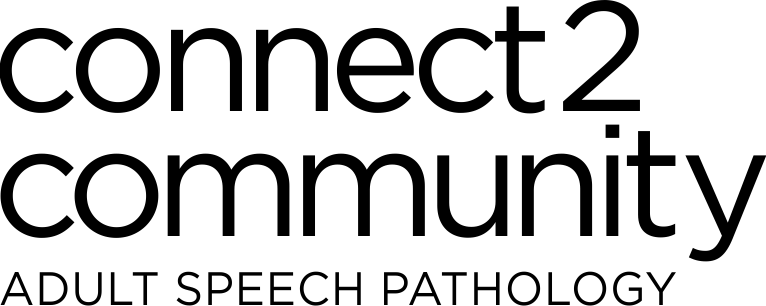

NORMAL AGEING
Communication in the context of normal ageing
There are inevitable physiological changes within the body due to the process of ageing. However, the rate and severity of these changes vary from person to person and interact with social and psychological factors, making one person’s experience of being in older age very different from that of another. Both communication and swallowing are subject to changes with the natural ageing process, and many of the diseases that are prevalent in older age have symptoms related to both communication and swallowing.
As we age, aspects of communication may change and older people might not be able to communicate with the same ease as they did when they were younger.
Physiological changes to communication in normal ageing
Dentition
The effect of loose-fitting dentures on articulation precision can lead to reduced clarity of speech sound production
Presbyopia
A term used to describe changes in eyesight can result in difficulty accessing written material, especially small print
Presbycusis
A term used to describe loss of hearing. Hearing loss can have a marked effect on the ability to communicate effectively and comfortably. Words and meanings can be missed, and it takes increased effort to listen and participate in valued conversations.
Breath support for voice and speech
Ageing effects on the respiratory system can lead to increased respiratory challenge when speaking and a subsequent reduction in breath support for effective voice productions and speaking.
Voice
Voice quality can change. The voice can become weaker and breathier sounding. Reduced breath support can affect voice production.
Word retrieval
Word finding difficulty or the tip-of-the-tongue phenomenon can lead to frustration and reduced confidence participating in conversation with others (e.g., the person knows the word they want to say and may even be able to think of the first sound, but the rest of the word doesn’t come easily).
Comprehension and auditory processing
Relatively slower processing of spoken language
Comprehension may be more difficult when ‘out of context’
Cognitive (thinking) skills
Gradual decline in executive functioning, processing speed and learning. Semantic memory can decline (general knowledge or memory for concepts, facts and the meaning of words).
Conversational skills
Affected by unclear pronoun references in conversation
Affected by increased frequency of off-topic talking in conversation
Reading
Affected by visual changes. Fatigue, reduced concentration or attention may impact reading ability particularly more complex or unfamiliar reading material
Writing
Affected by visual changes. Tip of the tongue phenomenon can also occur with spelling, and word retrieval can be present in writing as well as speech.
It’s important to be aware of the following:
- A speech pathologist has comprehensive knowledge for the ‘normal physiological changes’ often seen in ‘communication and normal ageing’ and is therefore alert to changes in communication that might indicate underlying pathology (i.e., disease-related communication conditions).
- Neuroplasticity and treatment potential continues throughout the lifespan, particularly if there is a good physical and cognitive reserve as a baseline. Older people are capable of learning new skills. Older people can compensate for decline in neural activity by recruiting from other parts of the brain.
- Early intervention with older adults showing risk factors for significant ageing effects is very important. Intervention at an early stage allows an older person to develop a greater reserve to mitigate later related decline and to reduce the risk of deteriorating to a state that is less reversible.
A speech pathologist can:
- Identify whether a client is presenting with normal age-related communication decline or individual risk factors for possible communication changes related to an underlying pathological cause.
- Identify a holistic profile of a client’s communication needs and ability
- Collaborate with client and family towards person-centered therapy goals
- Provide treatments that meet the client’s communication needs and goals. All treatments focus on real-life, meaningful situations and tasks to enhance success in communication
- Provide compensatory approaches for the client in the form of strategies to facilitate successful communication with significant others
- Provide communication partner training and support for the client and their close communication partners to enhance successful conversation.
- Identify barriers and facilitators within the person’s environment, with the goal being – how to best support communication for the older person within their community.
- Provide ‘normal ageing’ specific education for the client and family
Eating, drinking and swallowing in the context of normal ageing
The act of eating, drinking and swallowing becomes different as we age. As with other age-related changes, this process also alters gradually in most healthy older people and with varying severity depending on the underlying reserve of the older person. The delicate process of swallowing is easily interfered with, and any changes to eating, drinking and swallowing can lead to significant impact on an older person’s life.
Swallowing impairments, termed ’dysphagia’ are common symptoms of many diseases that are more prevalent in the older population. Age-related swallowing disorders are sometimes termed ‘presbyphagia’, which sets it apart from disease-related dysphagia.
Summary of typical changes to the phases of swallowing in older persons
Sensory impairments
Reduced sense of smell can lead to a reduction in the production of saliva required for chewing
Reduced vision impacting use of utensils, transfer of food to mouth, ability to distinguish the food on the plate
Dentition
Missing dentition and ill-fitting dentures will affect the ability to chew and bite
Oral health
Altered saliva production and subsequent dry mouth can lead to increased risk of infection, altered taste and discomfort when eating and drinking
Taste sensation
Sensation of taste can change as a direct result of age-related change in sense of smell, and reduced density of taste buds
Tongue muscles
Weakness in the tongue due to naturally occurring sarcopenia (a process involving loss of skeletal muscle fibres and reduced strength)
Weaker tongue muscles affect the pressure generation of food/fluid bolus
Pharyngeal phase of swallow
Slower initiation of the swallow
Weaker throat muscles
Increased chance of bolus residue (food or fluid remnants) remaining in throat area
Reduced sensory awareness
Increased chance of food/fluid penetrating the top of the airway (the voice box/larynx)
Oesophageal phase of swallowing
Research has found that oesophageal peristalsis (wavelike movement of the oesophageal muscles) used to move the food or fluid bolus towards the stomach starts to reduce after the age of 40.
Increased duration of upper oesophageal sphincter (a muscular valve that opens and closes to allow food and fluids to pass into the oesophagus or food pipe) opening with slower return to resting closed position may increase the risk of reflux or regurgitation
It’s important to be aware of the following:
- A speech pathologist has comprehensive knowledge for the ‘normal physiological changes’ often seen in ‘eating, drinking, swallowing and normal ageing’ and is therefore alert to atypical features of age-related swallowing changes that might indicate underlying pathology (i.e., disease-related dysphagia).
- Intervention at an early stage allows an older person with normal age-related swallowing changes to develop a greater reserve to mitigate later related swallowing decline and to reduce the risk of the swallow deteriorating to a state that is less reversible.
A speech pathologist can:
- Identify whether a client is presenting with normal age-related swallowing difficulties or individual risk factors for possible swallowing changes related to an underlying pathological cause.
- Identify a holistic profile of a client’s swallowing function and needs
- Collaborate with the client and family towards person-centered therapy goals
- Discuss treatments options specific to a client’s swallowing function, needs and goals
- Provide treatments that meet the client’s swallowing needs and goals. All treatments focus on real-life, meaningful mealtime activities and roles
- Identify barriers and facilitators within the person’s environment, with the goal being – how to best support the client and family’s participation in the mealtime environment
- Provide eating, drinking, swallowing and normal ageing specific education for the client and family.
Speech pathologists are trained to assess, diagnose, provide treatment and advocate for people with dysphagia. Please contact connect2community speech pathology if you have any concerns or questions regarding dysphagia or a recent diagnosis of dysphagia.
PHONE 0411 864 386
EMAIL info@connect2community.au
